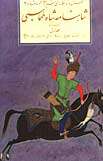نقاشی مینیاتور ایرانی دختر نشسته گل به دست سبک مکتب صفوی safavid style in persian iranian miniature



| Portrait of a Young Woman | Seated Princess Attributed to Mohammadi, Herat, circa 1565, By Soudavar. 2. While obviously a copy of the earlier work there are many key differences in execution. Some of the clues to attribution are the light green and the technique and color of the cypress tree. |
||
|
 |
||
| Detail - Portrait of a Young Woman | Detail - Seated Princess | ||
|
|
||
| Detail - Portrait of a Young Woman | Detail - Seated Princess | ||
|
|
||
| Portrait of a Young Woman | Detail - Nushaba Recognizes
Iskandar From His Portrait attributed to Mirza Ali, Qazvin, circa 1540 3. From the Khamsa of Nizami. |
1. Welch, Stuart Cary Wonders of the Age. Cambridge: Fogg Art Museum, Harvard University. 1979. cat. 84, page 185 and plate 70.
2.Soudavar, Abolala. Art of the Persian Court. New York: Rizzoli, 1992, page 237plate 93.
3. Welch, Stuart Cary. Persian Painting Five Royal Manuscripts of the Sixteenth Century. New York: George Braziller. 1976. Page 80, plate 24.
N.B. My ongoing translation and commentary on "La Miniature En Orient" is a work in progress. I am publishing it one plate at a time in no particular order. I flip through the book and look for one that looks fun and then I do that one next. I suppose the order in which I publish them says something about my taste in art. My primary goal with this project is not to teach you about Islamic Art but rather it is to teach myself a little about Islamic Art. If I make an error please let me know. I am also doing the project this way so that if I make an error perhaps one of you will catch it for me. By the way I also decided that this would be a chance to learn a little more French, since I barely know enough to make it through a French menu.
For Further Reading:
Islamic art and Persian Miniature Paintings
More Oriental Rug Notes by Barry O'Connell
نقاشی مینیاتور ایرانی دختر نشسته گل به دست سبک مکتب صفوی safavid style in persian iranian miniature painting
 He
was born around 858 in Tur, Persia to a cotton-carder (Hallaj means
“cotton-carder” in Arabic). Al-Hallaj’s grandfather may have been a
Zoroastrian. His father lived a simple life, and this form of lifestyle
greatly interested the young al-Hallaj. As a youngster he memorized the
Qur’an and would often retreat from worldly pursuits to join other
mystics in study.
He
was born around 858 in Tur, Persia to a cotton-carder (Hallaj means
“cotton-carder” in Arabic). Al-Hallaj’s grandfather may have been a
Zoroastrian. His father lived a simple life, and this form of lifestyle
greatly interested the young al-Hallaj. As a youngster he memorized the
Qur’an and would often retreat from worldly pursuits to join other
mystics in study.Hallaj would later marry and make a pilgrimage to Mecca, where he stayed for one year, facing the mosque, in fasting and total silence. After his stay at the holy city, he traveled extensively and wrote and taught along the way. He travelled as far as India and Central Asia gaining many followers, many of which accompanied him on his second and third trips to Mecca. After this period of travel, he settled down in the Abbasid capital of Baghdad.
During his early lifetime he was a disciple of Junayd and Amr al-Makki, but was later rejected by them both.
Among other Sufis, Hallaj was an anomaly. Many Sufi masters felt that it was inappropriate to share mysticism with the masses, yet Hallaj openly did so in his writings and through his teachings. He would begin to make enemies, and the rulers saw him as a threat.This was exacerbated by times when he would fall into trances which he attributed to being in the presence of God. During one of these trances, he would utter Ana al-Haqq أنا الحق, meaning “I am the Truth,” or “I am God” and also, “In my turban is wrapped nothing but God?” which was taken to mean that he was claiming to be God, as Al-Haqq is one of the Ninety Nine Names of Allah. In another statement, Hallaj would point to his cloak and say, “Maa Fil Jubbati Illa-Allah” meaning “There is nothing inside/underneath the cloak except God.”
This utterance would lead him to a long trial, and subsequent imprisonment for eleven years in a Baghdad prison. In the end, he would be tortured and publicly crucified (in some accounts he was beheaded and his hands and feet were cut off) by the Abbasid rulers for what they deemed “theological error threatening the security of the state.” Many accounts tell of Al-Hallaj’s calm demeanor even while he was being tortured, and indicate that he forgave those who had executed him. According to some sources, he went to his execution dancing in his chains. He died on March 26, 922.
فهرست نقاشی سبک مکتب صفوی صفویه صفویان مینیاتور نگارگری آبرنگ Safavid style painting
 |  |  |  |
 | |||
 |  | ||
 |  | ||
 | |||
 |  |  | |
 | |||
 |






















 beautiful fine art - basic find all
beautiful fine art - basic find all